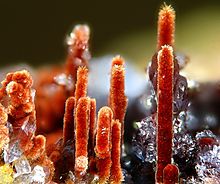| Carminite | |
|---|---|
 Carminite from the Alto das Quelhas do Gestoso Mines, Gestoso, Manhouce, São Pedro do Sul, Viseu District, Portugal. Picture width 1.5 mm. | |
| General | |
| Category | Arsenate minerals |
| Formula (repeating unit) | PbFe3+2(AsO4)2(OH)2 |
| IMA symbol | Cmt[1] |
| Strunz classification | 8.BH.30 (10 ed) 7/B.28-40 (8 ed) |
| Dana classification | 41 Anhydrous phosphates, arsenates and vanadates containing hydroxyl or halogen |
| Crystal system | Orthorhombic |
| Crystal class | Dipyramidal (mmm) H-M symbol: (2/m 2/m 2/m) |
| Space group | Cccm |
| Unit cell | a = 16.591 Å, b = 7.58 Å, c = 12.285 Å; Z = 8 |
| Identification | |
| Formula mass | 639.87 g/mol |
| Colour | Carmine red |
| Crystal habit | Typically bladed crystals, also acicular crystals, in spherical or tufted aggregates and as fibrous or drusy masses |
| Cleavage | Distinct on {110} |
| Tenacity | Brittle (D, All) |
| Mohs scale hardness | 3+1⁄2 |
| Lustre | Vitreous, pearly on cleavages |
| Streak | Reddish yellow |
| Diaphaneity | Translucent |
| Specific gravity | 5.03–5.18 |
| Optical properties | Biaxial (+) |
| Refractive index | nα = 2.070, nβ = 2.070, nγ = 2.080 |
| Birefringence | 0.010 |
| Pleochroism | strong, X= pale yellowish red; Y=Z= dark carmine red |
| Solubility | Slowly soluble in HCl with the separation of PbCl2, and totally soluble in HNO3 |
| Other characteristics | Carminite is not radioactive. No piezoelectric effect could be detected[2] |
| References | [3][4][5][6][7] |


Carminite (PbFe3+2(AsO4)2(OH)2[8]) is an anhydrous arsenate mineral containing hydroxyl.[citation needed] It is a rare secondary mineral that is structurally related to palermoite (Li2SrAl4(PO4)4(OH)4).[8] Sewardite (CaFe3+2(AsO4)2(OH)2) is an analogue of carminite, with calcium in sewardite in place of the lead in carminite. Mawbyite is a dimorph (same formula, different structure) of carminite; mawbyite is monoclinic and carminite is orthorhombic.[4] It has a molar mass of 639.87 g.[5] It was discovered in 1850[4] and named for the characteristic carmine colour.[5][6]
- ^ Warr, L.N. (2021). "IMA–CNMNC approved mineral symbols". Mineralogical Magazine. 85 (3): 291–320. Bibcode:2021MinM...85..291W. doi:10.1180/mgm.2021.43. S2CID 235729616.
- ^ Rosenzweig, A and Finney, J J Finney (1959) American Mineralogist 44: 663–665
- ^ Mineralienatlas
- ^ a b c Carminite on Mindat.org
- ^ a b c Carminite data on Webmineral
- ^ a b Carminite in the Handbook of Mineralogy
- ^ Gaines et al (1997) Dana's New Mineralogy, Eighth Edition. Wiley
- ^ a b "Commission on New Minerals, Nomenclature and Classification". Archived from the original on 2011-12-29. Retrieved 2014-09-19.